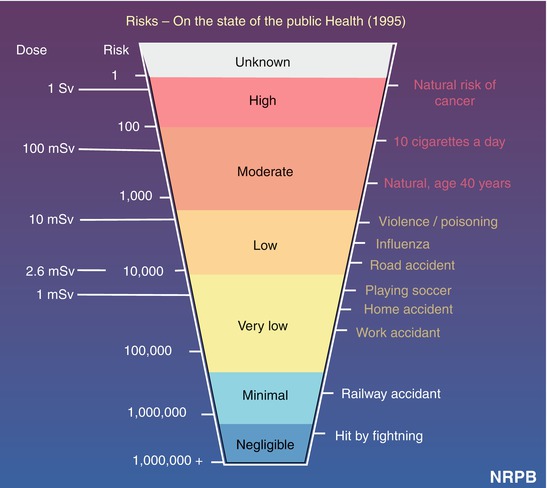(1)
Department of Nuclear Medicine, INHS, Asvini, Mumbai, India
Abstract
Question Will nuclear medicine scans have some side effects? Answer There is always a weighing between benefi ts and risk. If the benefi t is more and risk is less, then only these procedures are recommended and erformed. The radiation dose to the patient in nuclear medicine is within safe limits. Suitable doses of radiation are used in a controlled way to treat cancer patients. Obviously in this case the benefi ts of radiation exposure far outweigh the possible risks.
Question
Will nuclear medicine scans have some side effects?
Answer
There is always a weighing between benefits and risk. If the benefit is more and risk is less, then only these procedures are recommended and performed. The radiation dose to the patient in nuclear medicine is within safe limits. Suitable doses of radiation are used in a controlled way to treat cancer patients. Obviously in this case the benefits of radiation exposure far outweigh the possible risks.
Question
Will a nuclear medicine scan make me radioactive?
Answer
Yes, but the isotopes used are given in tiny amounts. They lose their radioactivity very quickly (usually within hours). They also pass out of the body quickly, usually within 24 h.
Question
Are there people who should not undergo nuclear medicine scans?
Answer
Generally, pregnant and breastfeeding women are not candidate of nuclear medicine scans; however, if the benefit is more than the risk, then it can be considered depending upon the procedure required. Some patients who have certain allergies or blood disorders may also be screened out. However, nuclear medicine injections are by and large safe since they are used in very tiny amount.
Question
What are radiation effects and risk estimates in nuclear medicine scans?
Answer
Radiation effects are classified as
(a)
Early effects
(b)
Late effects
Early effects have a threshold dose, above which it will be seen, whereas late effects have no dose limits. Early (deterministic) effect occurs every time a certain radiation dose level (or threshold dose) exceeded. Deterministic effects include reddening of the skin, sterility, cataracts, radiation sickness, and even death if the dose is high enough. Deterministic effects occur only after relatively high-dose levels exceed the threshold for those effects, usually a dose on the order of 100 rem* (1 Sv). Therefore, the risk of deterministic effects attributed to the exposures likely to be encountered in diagnostic nuclear medicine procedures is nil.
After a careful review of the evidence for radiation effects from the radiation doses associated with diagnostic nuclear medicine, there appears to be little reason for apprehension about late effects or stochastic effects [1]. Late effects happen only to a certain percentage of individuals in a group that is exposed to a given hazard. The principal stochastic effect from radiation doses associated with diagnostic nuclear medicine is cancer. Hereditary effects manifested in the offspring of exposed individuals are less likely. Incident of cancer in radiation workers is not more than in general population. Hence, it is safe for patients also.
*rem (roentgen equivalent in man) and sievert are units of equivalent dose, which is defined as the energy deposited per unit mass of any material by a particular type of radiation. 1 Sv = 100 rem.
Question
What is the probability of causing carcinoma by nuclear medicine scans?
Answer
Get Clinical Tree app for offline access

0.005 % per mSv of effective dose or in other words if 1 mSv dose is given, 5 in 1,00,000 people may be affected with carcinoma; this is again a probability. Every day, we live with all types of risk; this could be from traveling by road, rail, or air; smoking a cigarette; or using an electrical appliance.
All food materials contain radioactivity. A person who does not want any radioactivity in his food may not know that in his body about 15 million atoms of potassium-40 disintegrate every hour. Nearly one lakh cosmic ray neutrons and four lakhs secondary cosmic ray particles traverse his body every hour. In his lung 30,000 atoms of radon, polonium, bismuth, and lead disintegrate every hour. Thus, his body is irradiated with a shower of beta particles, alpha particles, neutrons, and gamma rays continuously throughout his lifetime [2].
There is even a risk from radiation depending on where we live. Naturally occurring background radiation is the main source of exposure for most people. Levels typically range from about 1.5–3.5 millisievert per year but can be more than 50 mSv/year. The highest known level of background radiation affecting a substantial population is in Kerala and southern states in India where some 140,000 people receive doses which average over 15 millisievert per year from gamma radiation in addition to a similar dose from radon. Natural radiation contributes about 88 % of the annual dose to the population and medical procedures most of the remaining 12 %. Natural and most artificial radiations are not different in kind or effect. Lifetime doses from natural radiation range up to several thousand millisievert. However, there is no evidence of increased cancers or other health problems arising from these high natural levels [3].
Over the past decades, some pioneer scientists reported that low-dose ionizing radiation often has a beneficial or hormetic effect. That is, low-level ionizing radiation may be an essential trace energy for life, analogous to essential trace elements. It has been even suggested that about one-third of all cancer deaths are preventable by increasing our low-dose radiation. In 1996, Yonezawa and his colleagues indicated that when 21-ICR (imprinting control regions) mice were exposed to an 8 Gy of X-rays, about 30 % of the animals survived 30 days after the irradiation. However, when mice are preirradiated with 5 cGy of X-rays, the survival rate increased to about 70 % [4].
As per report of road accident in India, 2009, there is 1 in 10,000 chance of dying from a road traffic accident and this is considered very rare. The figure below illustrates the probability of other types of risks such as hit by lightning, railway accidents, work accidents, road accidents, death by violence, and natural death at age of 40 years compared with risk of radiation exposed to certain doses.


Chart 3.1




Risk of radiation compared with other risks of life in day to day activities. Published by Cambridge University Hospital at website http://www.cuh.org.uk/cms/sites/default/files/publications/PIN2548_radiation_risk.pdf. [4]
Stay updated, free articles. Join our Telegram channel

Full access? Get Clinical Tree




